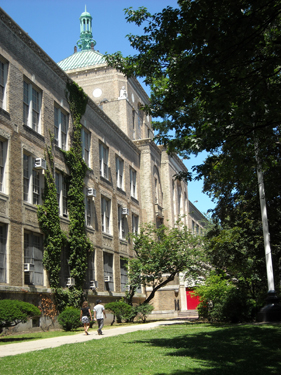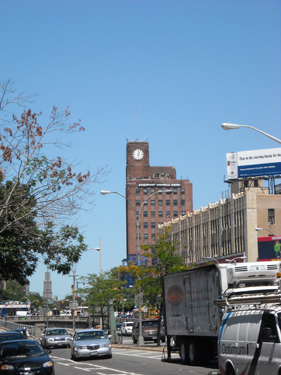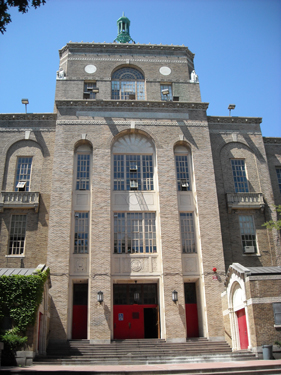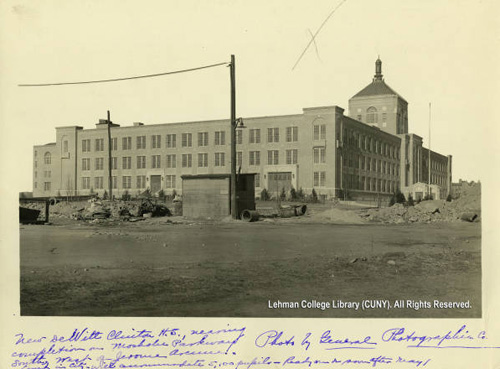DeWitt Clinton
High School

Mosholu Parkway between Goulden and Paul Avenues
William H. Gompert
1929
In 1908, The New York Times cynically but correctly prophesied that it would be some time “before the city is rid of the troublesome hole in the ground which it has spent so much of the taxpayer’s money in digging to no purpose.” The 135 acres in question belonged to the second, east basin of the Jerome Park Reservoir, between Goulden and Jerome Avenue, abandoned as unnecessary. Twenty years later it was still mostly derelict wasteland. But the forecast for its future had become improbably optimistic. This tract at the north margin of the city, according to the Bronx Board of Trade, was destined to become “the greatest educational center in the United States, if not the world.” The magical transformation from eyesore to potential acropolis was the work of circumstances. Seething growth in the student population was pressuring the city to expand existing public high schools and colleges. Land in Manhattan was increasingly unaffordable. But available lots in the outer boroughs had recently become (or were about to become) accessible by subway. The Woodlawn and Grand Concourse lines would make it easy for commuting high school and college students, as well as other visitors from downtown, to reach the reservoir. There were plans for a high school of music with attached concert halls, and a museum of science and industry. Hunter College wanted land for a satellite campus. And a new home for DeWitt Clinton, New York’s largest academic high school, was already under construction at the Mosholu Parkway end of the basin.
The new Clinton was finished in 1929, just before the arrival of the Depression trimmed many of these projects. Its predecessor, the 1905 work of architect C.B.J. Snyder, is located at 58th Street and Tenth Avenue in Manhattan, where as Haaren Hall it today forms part of John Jay College (CUNY). Built to house 3,500, the striking Flemish Renaissance building had already been outgrown by 1917, when the Board of Education acquired 45 acres of the reservoir site. Plans for the Bronx Clinton were not drawn up until the mid-twenties, by which time Snyder had been replaced as Superintendent of School Building by William H. Gompert. A prodigious builder—he put up one hundred and seventy new schools in his brief five-year tenure—Gompert enjoyed the advantages of frequently designing schools for the outer boroughs. Snyder’s Clinton, for instance, had required an innovative H-plan to shoehorn five stories of classrooms, auditorium, and gymnasium into a narrow midtown block. Gompert’s Clinton, on the other hand, has been allowed to sprawl over its generous site. The three-story main building has a hollow rectangular plan. Its long side, facing Mosholu Parkway, is bisected by an axis that passes from the towered entrance, through the large auditorium in the middle of the interior courtyard, and out along corridors to a gymnasium to the south. Because the main building stands at the brink of the old excavation, Gompert was able to fix the base of the auxiliary building two stories below street level, where it opens onto athletic fields reached by terraces and stairs from the campus above. As a result, the bulky gym doesn’t break Clinton’s low profile, and leaves its outstanding architectural feature, an immense tower-lantern with pyramidal roof and attenuated cupola, in eye-catching isolation.
Clinton’s relaxed plan and great size bring their own design problems. There are beautiful screens of trees on three sides of the school. (Thirteen oaks, one for each original colony, were planted along the Parkway for the opening.) Behind the foliage, however, long horizontal rows of double windows, without vertical division into bays or frames in relief, give the light-colored brick exterior a factory-like monotony.
The effect is seconded by the school’s simplified massing and the elimination of all but small-scale ornament from its flat walls. Snyder’s picturesque Clinton belonged to an era which delighted in detailed historical re-creations. Gompert’s Clinton is part of the architectural transition to “the modern.”
But in 1929, that transition was still incomplete, and Clinton, like many hotels and apartment houses of the era, seeks a precedent (and remedy) for its planar blockiness in elements of the Lombard Romanesque style. These reveal themselves to close-range circumambulation in surprises such as lion-head corbels, chevron carving on doorways, interlace motifs in brickwork, inlaid roundels of patterned marble, and two ornamented miniature “chapels” which shelter the students’ stairways. Romanesque models account for the tall, semicircular-headed, shallow blind arches that adorn the corners of the school and culminate in three high apertures, in the form of a triumphal arch, which serve as the main entrance. The massive tower above more emphatically repeats the motifs of round arches and roundels. In a final expressive gesture, its low-pitched roof is topped by an extravagant ornament, a copper stalk of acanthus leaves supporting a thin, tall domed cupola, something between a minaret and a steamboat whistle.
Only four years after its opening, 5,600-seat Clinton found its enrollment raised by the Depression (and its anti-child labor laws) to an incredible 12,000, accommodated in multiple-sessions at the main building, as well as in five annexes distributed through two boroughs. It remained the most populous New York high school for most of the Twentieth Century.
David Bady
Photographs:
Lehman College Art Gallery and
Lehman College Library/CUNY and Lehman College Art Gallery



